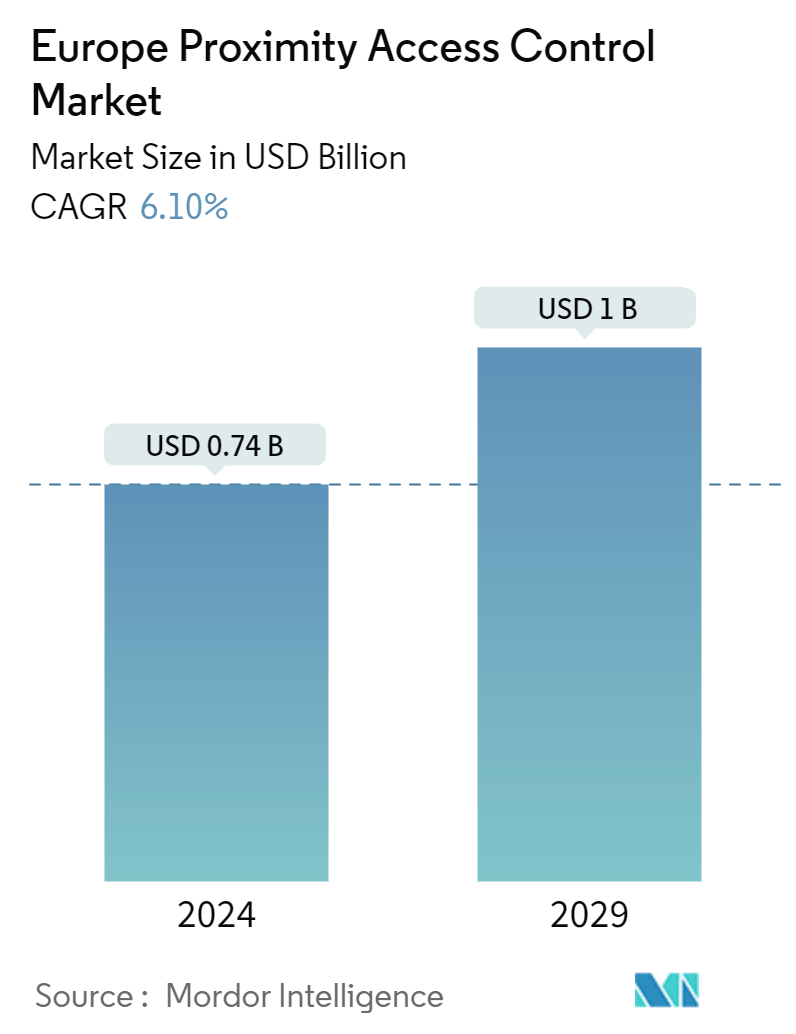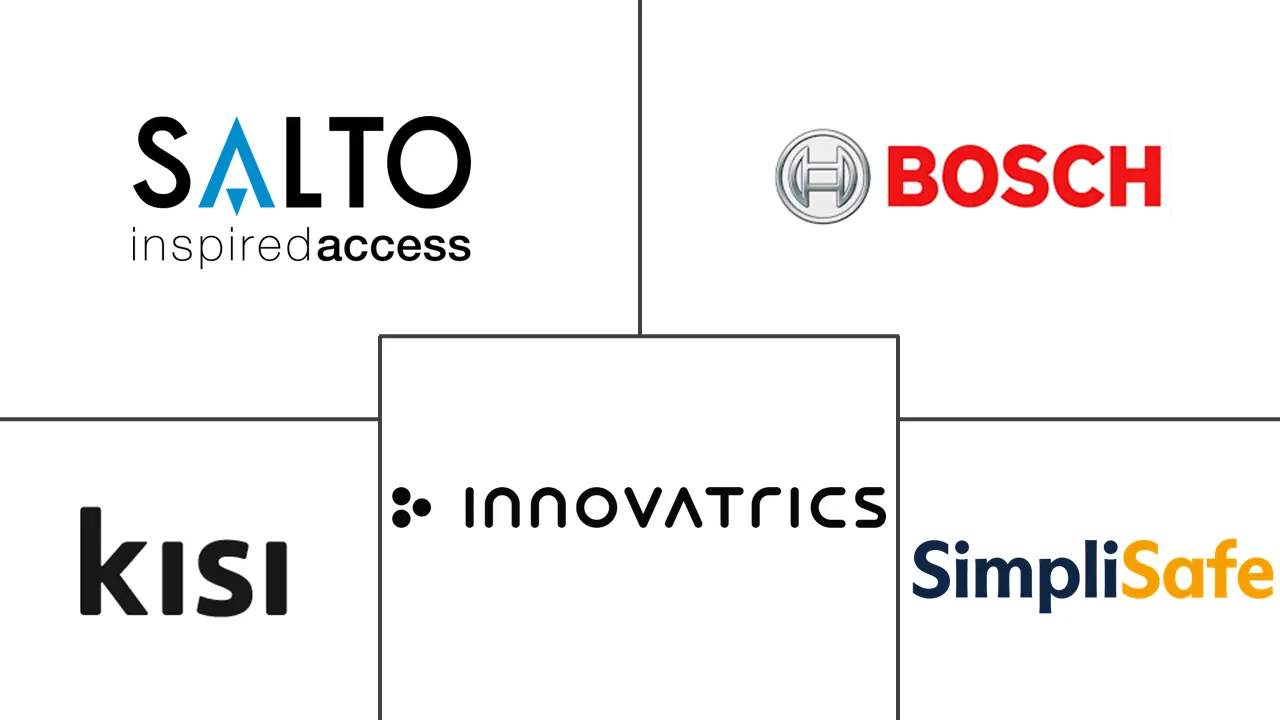Market Size of Europe Proximity Access Control Industry

| Study Period | 2019 - 2029 |
| Base Year For Estimation | 2023 |
| Market Size (2024) | USD 0.74 Billion |
| Market Size (2029) | USD 1 Billion |
| CAGR (2024 - 2029) | 6.10 % |
| Market Concentration | Low |
Major Players
*Disclaimer: Major Players sorted in no particular order |
Europe Proximity Access Control Market Analysis
The Europe Proximity Access Control Market size is estimated at USD 0.74 billion in 2024, and is expected to reach USD 1 billion by 2029, growing at a CAGR of 6.10% during the forecast period (2024-2029).
- Organizations are actively seeking advanced technology solutions, such as proximity access control systems, to bolster their security measures in response to the surge in theft, burglaries, and other disruptions. They aim to not only secure their facilities but also to enhance and expand their safety operations. The most common use of proximity cards is for access to residential areas, secure areas, parking spaces, and doors.
- The growing construction of residential buildings and large apartments in major cities such as Germany, the United Kingdom, France, and Sweden will create a huge demand for proximity access control systems. For instance, in March 2024, Germany approved the construction of 18,500 new homes. Additionally, the German government announced a substantial EUR 18.9 billion (USD 20.22 billion) in subsidies earmarked for new constructions and building renovations in 2024. Such factors will boost the demand for proximity access control systems.
- The popularity of proximity cards is due to their cost-effectiveness, low maintenance requirements, ease of use, and security features. Europe has adopted comprehensive data protection legislation, including the General Data Protection Regulation (GDPR), and proximity access control systems assist organizations in meeting these requirements by offering secure access controls and data protection safeguards.
- Europe's businesses and institutions are undergoing a process of infrastructure modernization, necessitating advanced access control solutions to replace obsolete systems. This trend of proximity access control solutions aligns with the region's progress in technology and innovative building initiatives. Smart cities provide a variety of advantages, such as integrated access control, CCTV surveillance, smart road systems, and public safety monitoring. For example, in July 2024, the United Kingdom had an average population density of 280 inhabitants per km2, making it an ideal location for implementing smart cities.
- Proximity access control systems can result in significant cost savings over time. These systems reduce the need for personnel changes to rekeying locks, minimize the risk of lost and stolen keys, and simplify access management access. In Europe, sectors such as healthcare and education need proximity access control solutions to protect patient records, pharmaceutical products, and educational institutions. These systems also facilitate the efficient management of attendance and visitor access. The security of governments and critical infrastructure facilities in European countries like Germany, the United Kingdom, and France is paramount, thus necessitating the implementation of proximity access control systems to protect sensitive locations, data centers, and governmental buildings.
- Proximity access control systems are typically considered secure; however, potential risks are associated with their use, such as hacking or unauthorized access to the system. Also, compliance with regulatory requirements can be challenging, particularly in highly regarded industries, such as financial services, government services, and information technology (IT). This step can lead to additional costs and effort, thus impeding the market's growth.
- The ongoing geopolitical conflicts in Europe, such as the Ukraine war, have reduced consumer spending. Further, the construction segment grapples with a significant challenge; FIEC's data is projected to decline by 5.7% in residential construction in 2024, compounding a 2.6% decrease from the previous year. Such factors are expected to hamper market growth for a short period.
Europe Proximity Access Control Industry Segmentation
Proximity is a wireless technology that enables access control devices to interact with each other wirelessly. Proximity access control systems run on low-frequency RFID technology, meaning their operating frequency is within the 120 kHz range.
The study tracks the revenue accrued through the sale of proximity access control software and hardware by various players in the European market. The study also tracks the key market parameters, underlying growth influencers, and major vendors operating in the industry, which will support the market estimations and growth rates during the forecast period. The study further analyses the overall impact of COVID-19 aftereffects and other macroeconomic factors on the market. The report’s scope encompasses market sizing and forecasts for the various market segments.
The European proximity access control market is segmented by solution (hardware and software), type (card readers, biometric scanners, proximity readers, alarms, metal detectors, door controllers, and wireless locks), end-user industry (government services, banking and financial services, IT and telecommunications, transportation and logistics, retail, healthcare, residential, and other end-user industries), and country (United Kingdom, Germany, France, and Rest of Europe). The market sizes and forecasts are provided in terms of value (USD) for all the above segments.
| By Solution | |
| Hardware | |
| Software |
| By Type | |
| Card Readers | |
| Biometric Scanners | |
| Proximity Readers | |
| Alarms | |
| Metal Detectors | |
| Door Controllers | |
| Wireless Locks |
| By End-user Industry | |
| Government Services | |
| Banking and Financial Services | |
| IT and Telecommunications | |
| Transportation and Logistics | |
| Retail | |
| Healthcare | |
| Residential | |
| Other End-user Industries |
| By Country*** | |
| United Kingdom | |
| Germany | |
| France |
Europe Proximity Access Control Market Size Summary
The European proximity access control market is experiencing a notable expansion, driven by the increasing demand for advanced security solutions across various sectors. Organizations are investing in proximity access control systems to enhance security measures in response to rising incidents of theft and unauthorized access. These systems are widely used for securing residential areas, parking spaces, and restricted access points. The construction of new residential buildings in major European cities, coupled with the region's focus on infrastructure modernization and smart city initiatives, is expected to significantly boost the demand for these systems. The cost-effectiveness, low maintenance, and compliance with data protection regulations like GDPR further contribute to the growing adoption of proximity access control solutions.
The market is characterized by a competitive landscape with several key players striving to expand their presence through strategic partnerships, product innovations, and mergers. The integration of biometric technology into access control systems is gaining traction, driven by the need for enhanced security and regulatory compliance in sectors such as finance, government, and healthcare. Despite challenges posed by geopolitical tensions and economic fluctuations, the market is poised for growth, supported by ongoing advancements in technology and the increasing urbanization of developing regions. The adoption of proximity access control systems is expected to continue rising, particularly in the United Kingdom, where security concerns and the need for efficient access management are paramount.
Europe Proximity Access Control Market Size - Table of Contents
-
1. MARKET INSIGHTS
-
1.1 Market Overview
-
1.2 Industry Attractiveness - Porter's Five Forces Analysis
-
1.2.1 Bargaining Power of Suppliers
-
1.2.2 Bargaining Power of Consumers
-
1.2.3 Threat of New Entrants
-
1.2.4 Threat of Substitutes
-
1.2.5 Intensity of Competitive Rivalry
-
-
1.3 Impact of COVID-19 Aftereffects and Other Macroeconomic Trends on the Market
-
-
2. MARKET SEGMENTATION
-
2.1 By Solution
-
2.1.1 Hardware
-
2.1.2 Software
-
-
2.2 By Type
-
2.2.1 Card Readers
-
2.2.2 Biometric Scanners
-
2.2.3 Proximity Readers
-
2.2.4 Alarms
-
2.2.5 Metal Detectors
-
2.2.6 Door Controllers
-
2.2.7 Wireless Locks
-
-
2.3 By End-user Industry
-
2.3.1 Government Services
-
2.3.2 Banking and Financial Services
-
2.3.3 IT and Telecommunications
-
2.3.4 Transportation and Logistics
-
2.3.5 Retail
-
2.3.6 Healthcare
-
2.3.7 Residential
-
2.3.8 Other End-user Industries
-
-
2.4 By Country***
-
2.4.1 United Kingdom
-
2.4.2 Germany
-
2.4.3 France
-
-
Europe Proximity Access Control Market Size FAQs
How big is the Europe Proximity Access Control Market?
The Europe Proximity Access Control Market size is expected to reach USD 0.74 billion in 2024 and grow at a CAGR of 6.10% to reach USD 1 billion by 2029.
What is the current Europe Proximity Access Control Market size?
In 2024, the Europe Proximity Access Control Market size is expected to reach USD 0.74 billion.

